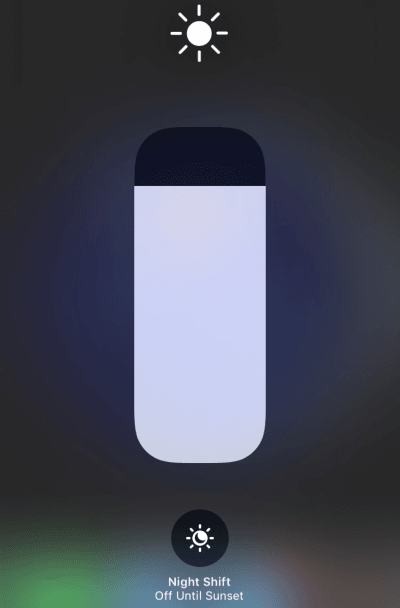
February 20, 2019 at 5:54 p.m. PST
By default, the brightness controls on the iPhone and iPad don’t give you full control over screen luminosity. This article demonstrates how to turn off iPhone and iPad Auto-Brightness.
Table of Contents:
- Why Does My iPhone’s Brightness Setting Change?
- Auto-Brightness Setting Has Moved
- How Does Auto-Brightness Work?
- Why Turn off Auto-Brightness?
- How to Turn off Auto-Brightness
- Apple Needs to Improve Auto-Brightness Usability
Why Does My iPhone’s Brightness Setting Change?
Launching Control Center on my iPhone, I turn down the screen brightness to preserve battery life as I download a movie. To my surprise, the screen gradually becomes brighter on its own. Did I merely just think I changed screen brightness? I try it again, with the same result. This is not a bug. It’s by design. This is Apple’s Auto-Brightness feature.
Apple critics have long laid claim that their devices are never truly yours. Apple doesn’t let users do much customization. They are notoriously heavy-handed with user interaction. It’s almost as if you don’t truly own that iPhone or iPad you purchased!
Apple’s Auto-Brightness is another example of Cupertino overriding their users. Auto-Brightness has been around since iOS 5. With iOS 11, Apple clearly wants the user to stick with Auto-Brightness, making it difficult to deactivate.
Auto-Brightness Setting Has Moved
Both iOS 11 and iOS 12 have the Auto-Brightness setting removed from Display & Brightness settings. This is a puzzling move for a company that takes great pride in user interface design. The setting has been moved to Accessibility features, which is already overcrowded.
Accessibility is not just for the disabled. It also seems to be the rug that Apple sweeps undesirable settings under. If they don’t want you to adjust something, they bury the settings under Accessibility. This is hardly good user interface design.
How Does Auto-Brightness Work?
Auto-Brightness automatically adjusts screen brightness on your iPhone or iPad. This feature is not available on the iPod touch. It uses the built-in ambient light sensor to decrease brightness in dark environments and increase luminosity in bright settings.
With Auto-Brightness, the actual screen brightness slider control moves automatically with changes in ambient light. If the user changes brightness, it will revert back to the algorithmic setting.
Automatic brightness adjustment eventually overrides any action the user takes. Essentially, it is an example of one of the biggest user interface flaws — “lying to the customer”.
A brightness control is displayed, but the user does not really control it. When Auto-Brightness is activated, the brightness control should be disabled and grayed out. Think of a new user who is puzzled as to why their brightness setting keeps changing. Even I thought it was a defect, at first.
Why Turn off Auto-Brightness?
Auto-Brightness is a remarkably useful feature for most people in most situations. It allows your iPhone or iPad to automatically adjust screen brightness based on background lighting. Auto-Brightness makes a lot of sense for portable devices, which are routinely used in multiple settings.
Auto-Brightness can also preserve battery life in most situations. Power conservation is the whole point of Auto-Brightness. After all, if battery life were not an issue, most people would crank up brightness all the way, in most situations.
As useful as Auto-Brightness can be, it can also get in the way. The brightness slider should be there for a reason. Users should be able to adjust screen brightness and have this setting persist.
I turn down screen brightness when I am downloading movies and TV shows in order to preserve battery life. (iOS will terminate downloads if your device is locked and not plugged in to a charger.) Display brightness is one of the biggest power hogs on mobile devices. Ironically, Auto-Brightness can actually undermine power savings. The feature prevents users from turning down screen brightness for more than a few seconds.
The other problem is that sometimes users want a bright screen. I watch a lot of movies and TV shows on my iPad. I like to crank the brightness up to 80% or more when I watch videos on my iPad.
I found myself constantly fiddling with the brightness when Auto-Brightness was turned on. It’s ironic for a feature that’s designed to minimize user intervention. One of the best reasons to turn off Auto-Brightness is to actually simplify user interaction. With the setting turned off, screen brightness is static. It’s no longer a guessing game of what the algorithm will do.
How to Turn off Auto-Brightness
Turning off Auto-Brightness is easy, especially if you use Siri. Simply hold down the Home button and say “Auto-Brightness settings”. The Display Accommodations setting screen is displayed. From here, simply turn off Auto-Brightness.
You can also turn off Auto-Brightness by drilling down into Settings. Simply tap on Settings > General > Accessibility > Display Accommodations, then turn off Auto-Brightness.
If you wish to access this feature often, I recommend using Siri. There’s no way to add this setting to Control Center. Long-pressing the screen brightness control won’t show this setting either.
Apple Needs to Improve Auto-Brightness Usability
If you drilled down into Settings, you probably noticed that Accessibility is a hot mess. This presents an unfortunate irony. Many disabled people already have a difficult time using an iPhone or iPad. By overcomplicating Accessibility features, Apple has actually complicated usability for the disabled, to some degree.
Don’t get me wrong. Apple’s Accessibility features are peerless. Disabled advocacy groups have been singing the praises of Apple for decades. Their competitors don’t cater to the disabled. It’s not cost effective, but it’s the right thing to do. The next time you complain about Apple’s greed, remember the Accessibility features.
That said, Apple is still committing a grievous usability crime. If you have a control that users can adjust, but it adjusts itself later, that’s a huge usability problem. There are better ways to design this feature.
One simple improvement would be to put the Auto-Brightness setting back under Display & Brightness settings. This doesn’t solve the problem of lying to the customer, as the brightness control will still move on its own. At least the end user will have a clue as to why this is happening.
Ideally, the brightness control should be deactivated when Auto-Brightness is in effect. It should be grayed out. Turning off the Auto-Brightness setting would activate the control and display it in full color.
Another great improvement would be adding Auto-Brightness to Control Center. Simply long press the brightness control and the Auto-Brightness setting could be right there, along with Night Shift settings.
One could argue that, as it stands, the user has the ability to temporarily adjust brightness. The problem is, the brightness control doesn’t display any indication that its adjustment is ephemeral. Who would think that adjusting brightness would work for n seconds and then it is automatic? It’s very confusing, especially to new users.
Overall, I think Apple excels at usability, especially when it comes to the actual physical device. For example, the way an iPhone or iPad fit in your hands and the responsiveness of controls exhibits excellent usability. The way iOS is designed is also straightforward, for the most part. They haven’t let third parties foul the user experience, unlike their competitors.
Auto-Brightness is not the first time Cupertino has fouled usability. Control Center used to have multiple screens to swipe through. The iPad version of Control Center was launched from the bottom of the screen, which often collided with launching the Dock. They eventually did the right thing and fixed these issues. I hope to see Apple do something better with iOS 13 and fix glaring usability problems with Auto-Brightness.



